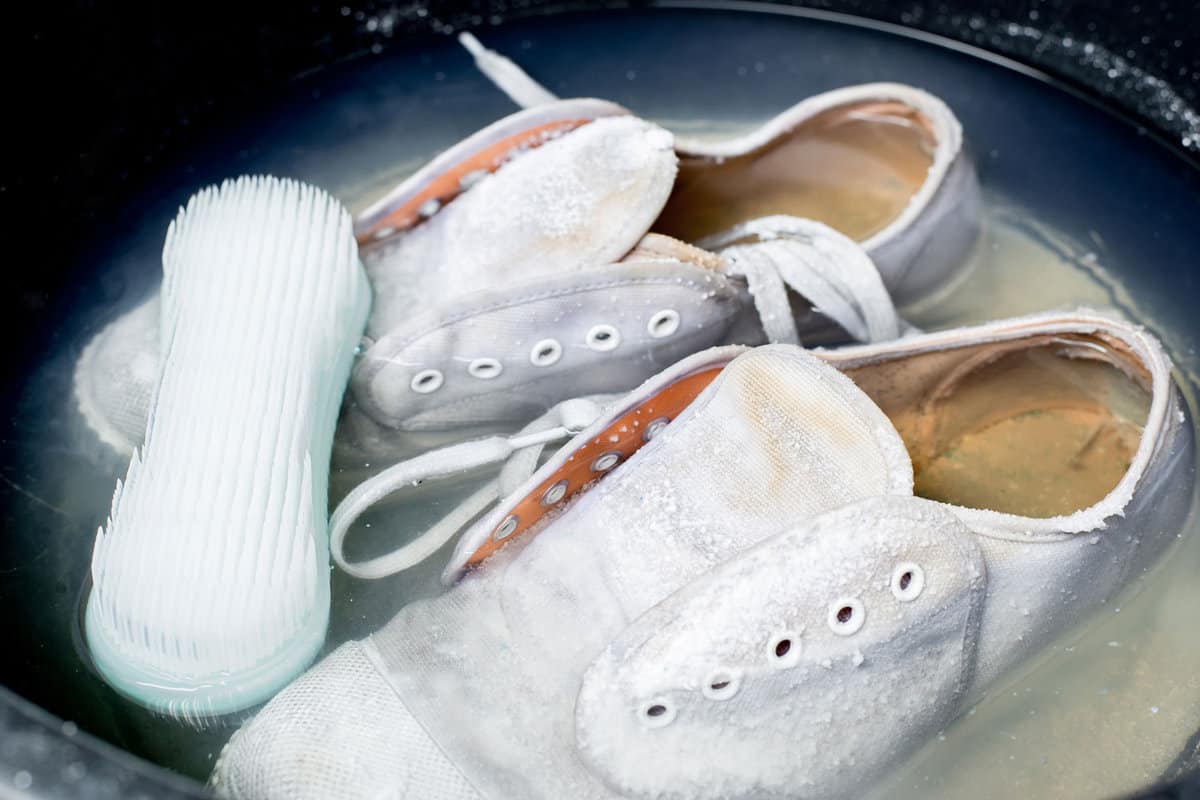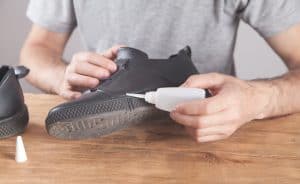White shoes are a versatile and stylish wardrobe staple, but they can also be challenging to keep clean.

This article may include affiliate links and elements that were carefully created by our team using advanced ai to help you envision the best style advice.
One common problem that many people face is dealing with mud stains on their beloved white sneakers.
We aim to provide you with a comprehensive guide on how to restore your white shoes to their original pristine state by taking you through the process of removing stubborn mud stains.
Remember, the key to successful white shoe restoration is acting as soon as possible. The sooner you address the mud stains, the easier it will be to remove them.
By following the tips and methods provided in this article, you'll be well on your way to having your white shoes looking as good as new!
White Shoes Restoration: Mastering Mud Stains
Tailored Techniques for Different Soil Types
When dealing with mud stains on white shoes, identify the type of mud stain first, as different kinds may require specific treatment methods.
Color Variation
Mud stains can come in various colors, depending on the soil composition and minerals present. Common colors include reddish-brown, yellowish-brown, and grayish-black.

Paying attention to the color variation in a mud stain can help determine the most effective cleaning method.
For example, reddish-brown stains may indicate iron-based soil, whereas yellowish-brown stains might suggest clay-rich soil.
- Reddish-brown stains: To remove iron-rich mud stains, you can try using a water and vinegar solution by mixing equal parts white vinegar and water. The acidity in the vinegar helps break down the mud and iron residue, making it easier to remove.
- Yellowish-brown stains: For clay-rich mud stains, using a detergent with enzymes is often effective, as enzymes can break down the organic material found in clay soil. Scrubbing the stain gently with a soft-bristled brush and the enzyme detergent can help lift the stain.
Set-in Stains
Set-in mud stains can be more challenging to remove, as they have already dried and penetrated the shoe material. However, persistence and the right cleaning methods can go a long way in restoring your white shoes.
- Pre-treat the stain
Begin by gently brushing off any excess dried mud from your shoes. Be careful not to scratch or damage the shoe material.
2. Apply a stain remover or cleaning solution
Depending on the type of mud, apply an appropriate cleaning solution, such as a water and vinegar mixture or an enzyme-based detergent. Allow the solution to sit on the stain for a few minutes to loosen the dirt further.
3. Scrub gently
Use a soft-bristled brush or an old toothbrush to scrub the stained area. Be gentle to avoid damaging the shoe material, especially if it is a delicate fabric like mesh or canvas.
4. Rinse and repeat
Rinse the cleaned area with warm water and, if necessary, repeat the cleaning process until the set-in stain is removed.
Effective Mud Stain Removal Techniques
Before attempting to remove mud stains from your white shoes, it's essential to follow these pre-treatment tips:
- Wait for the mud to dry completely. It's easier to remove dry mud than wet mud.
- Use a blunt object, such as a butter knife or an old credit card, to gently scrape off the excess dried mud.
- Tap the shoes together to remove any loose dirt that may have fallen off during the scraping process.
These simple pre-treatment tips will make the subsequent cleaning steps more effective.

Use of Detergents
After pre-treating the shoes, using a mild detergent is an effective way to remove the remaining stains. Here's a step-by-step guide to clean your shoes using detergent:
- Mix a few drops of liquid laundry detergent with a cup of warm water.
- Dip a soft cloth or sponge into the solution and gently work it into the stained area.
- Use a toothbrush dipped in the cleaning solution to scrub more challenging spots gently.
- Rinse the cloth or sponge with clean water and gently wipe the shoes to remove any detergent residue.
Always remember to test the detergent on an inconspicuous area of the shoe first to ensure it doesn't cause harm to the material.
Use of Vinegar
Another effective technique for removing mud stains from white shoes involves using white vinegar. Follow these steps:
- Mix equal parts of baking soda and distilled white vinegar to create a cleaning paste.
- Apply the paste to the stained areas using a toothbrush, gently scrubbing to lift the stains.
- After scrubbing, use a damp cloth to wipe off the cleaning paste.
- Let the shoes air dry in a well-ventilated area.
This process will work on canvas shoes. Addiotionally, remember to check the shoe manufacturer's guidelines for cleaning materials to avoid any potential damage caused by using vinegar.
Restoring the Color of White Shoes
Restoring the color of white shoes can be challenging, but with the right techniques and products, you can have your shoes looking new again.
Bleaching Process

Bleaching is a powerful method for removing stubborn stains and restoring the original color of white shoes. However, use it with caution to avoid damaging your shoes. Here's a step-by-step guide on using bleach effectively:
1. Prepare the solution
Mix one part bleach with five parts water in a container. This diluted solution will be gentle on your shoes while still effectively removing stains.
2. Clean the shoes
Before bleaching, make sure to remove dirt and debris from your shoes. You can use an old toothbrush and mild detergent for this purpose.
3. Apply the bleach solution
Dip a clean cloth or soft brush into the bleach solution, and gently scrub the stained areas of your shoes. Be sure to avoid getting the solution on any colored logos or designs.
4. Rinse thoroughly
After scrubbing, rinse your shoes with clean water to remove any bleach residue.
5. Air dry
Allow your shoes to air dry in a well-ventilated area, away from direct sunlight.
Note that you shouldn't use bleach on delicate fabrics like leather or suede; however, it's effective at returning canvas sneakers to their original bright white color.
Use of Shoe Whitening Products
Shoe whitening products, such as magic erasers and commercial shoe cleaners, can be a great alternative to bleaching. You can use this product with the delicate material of white leather shoes.

These products are specifically designed for restoring the color of white shoes without causing harm to the materials. Here's how to use shoe whitening products:
1. Choose the right product
Make sure to select a whitening product that is compatible with your shoe's materials, whether it be canvas or mesh.
For fabric, mesh, or sneakers, you can also use toothpaste to remove stains, but avoid using toothpaste on leather shoes.
2. Clean the shoes
As with the bleaching process, you'll need to remove dirt and debris from your shoes before using a whitening product.
3. Apply the product
Follow the manufacturer's instructions for applying the whitening product to your shoes. This might involve using a cloth, sponge, or brush to gently work the product into the stained areas.
4. Allow the product to dry
Give the whitening product sufficient time to dry, typically a few hours, before wearing your shoes or exposing them to moisture.
5. Reapply as needed
If you notice that the stains haven't completely disappeared, you may need to repeat the process once or twice more.
Can I Machine Wash White Shoes?
Yes, some white shoes can be machine washed, but it is crucial to check the manufacturer's care instructions before doing so, as some shoe materials may not be suitable for machine washing.

Remove dirt and stains as much as possible before washing them, and always use a gentle cycle with cold water and mild detergent. Put the shoes in a mesh laundry bag and avoid using bleach or fabric softener.
Drying Your Restored White Shoes
Start by gently patting the shoes with a soft, clean cloth, absorbing as much moisture as possible from the outer surface.
Avoid rubbing or applying too much pressure, as this may cause unintentional damage or discoloration to the shoes.
Next, fill the shoes with crumpled paper towels, tissue paper, or clean cloth.
This will help absorb any remaining moisture from the inside, while also helping to maintain the shoe's proper shape during the drying process.

Replace the paper or cloth if it becomes too damp as needed.
Place the shoes in a well-ventilated area, away from direct sunlight or heat sources, such as radiators or heaters. Direct heat can cause the shoes to become misshapen, discolored, or damaged.
Allowing them to air-dry at room temperature ensures the materials can safely return to their natural state without any risk of harm.
Make sure the shoes are in an upright position for even drying. You may use a shoe tree or simply prop them up using other objects, ensuring they are stable and well-supported throughout the process.
Finally, give your shoes ample time to dry - this may take anywhere from a few hours to a full day or more, depending on the materials and the amount of moisture absorbed.
Resist the temptation to speed up the drying process with artificial heat sources, as patience will lead to the best results.
In Closing: Keep Your White Shoes Looking New
Taking care of your white shoes and removing mud stains doesn't need to be a daunting task.

By understanding the nature of mud stains and employing techniques like using vinegar, detergents, or even specialized whitening products, the task becomes manageable.
With patience and the right approach, your white shoes can continue to be a stylish asset in your wardrobe.
Read more:



